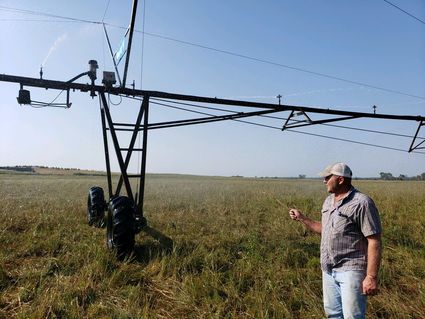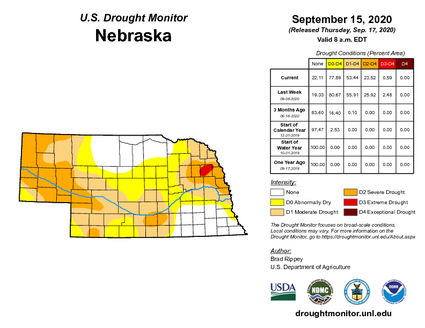Dry conditions affects farmers, producers
September 24, 2020

Mark Mahoney
Water source • The mostly dry weather during the past couple of months has taken a toll on beef producer Curt Thiele's center pivot irrigation system in the Clearwater area.
Antelope and Holt counties have been dealing with mostly dry weather for the past two months.
The two northeast Nebraska counties recently saw already dry conditions worsen, according to the U.S. Drought Monitor.
"Abnormal dryness extended northward for both," said Nebraska State Climatologist Martha Shulski, who is based at the University of Nebraska-Lincoln. "These areas missed out on rainfall that hit other parts of Nebraska the past few weeks."
The dryness in Antelope County started in early August and in Holt County in early September.
"This part of the state did not have the strong precipitation deficits that plagued other areas," Shulski said. "However, August was warm and quite dry, leading to degradations in pasture conditions and reductions in soil moisture reserves."
A year after Nebraska saw its wettest August on record, the state, in 2020, had its driest August in 126 years of recordkeeping.
According to the Nebraska State Climate Office, based at UNL, the statewide average of 0.78 inches of precipitation in August was nearly 2 inches below normal.
"Very dry conditions prevailed this August, rounding out a generally dry summer," according to the state climate office. "Statewide, precipitation was driest on record, going back to 1895."
Temperatures were mostly warmer than normal in August with triple-digit heat reported around Nebraska.
"Dryness and drought conditions intensified with the lack of rainfall and heat and now covers 80% of the state," according to the state climate office. "Impacts are being felt for rangeland, pastures and crop conditions and decreasing soil moisture reserves."
Beef producer Curt Thiele of rural Clearwater noted the lack of meaningful moisture in August was "rough and tough."
"Our rains have really been timely the first part of the season – May, June," Thiele said. "July was good."
The dry August weather made his center pivot irrigation system have to operate more than usual to water his crops and it required almost constant maintenance and repairs.
"It's taken a toll on pivots," Thiele said. "We're fighting three or four pivots a day, just every day, seven days a week."
He noted the dry conditions also have definitely taken a toll on the corn and soybeans planted on a few thousand acres of land he and his father, Fred, farm, especially the dryland corners where the center pivots do not reach.
"Dryland corner yields have dropped significantly," Thiele said.
He noted the crops that have been irrigated from the center pivots look good overall, but he will know more about their condition when he starts going through them with a combine during the next month.
Thiele said he is "lucky to have irrigation" because he would otherwise be dealing with a "disaster," as he put it.
He described the pastures where his few hundred head of Black and Red Angus cattle graze as "looking tough."
"That grass is done," Thiele said. "The cows will need to be brought home shortly."
For the normal year-to-date precipitation as of Sunday, Sept. 20, Antelope County is about 6 inches less than usual and Holt County is about 4 inches less than usual.
Shulski noted the normal year-to-date precipitation for Jan. 1-Sept. 20 for Antelope County is around 22 inches and slightly less for Holt County.
For example, Elgin has reported 16.32 inches for its 2020 year-to-date precipitation and its normal is 22.51 inches.
Other parts of northeast Nebraska have been hit harder with dry conditions than Antelope and Holt counties recently.
According to the U.S. Drought Monitor, Cuming County is dealing with severe to extreme drought, while surrounding counties are dealing with moderate, severe and extreme drought.
"Timing is everything, though, when it comes to dryness impacts," Shulski said. "In combination with heat, drought can have a rapid onset."
She shared the state climate office's October predictions for Antelope and Holt counties.
"Looking forward, the monthly outlook for October trends toward warmer and drier than average conditions," Shulski said. "So in terms of short-term relief, this area might not be able to make up deficits."






Reader Comments(0)